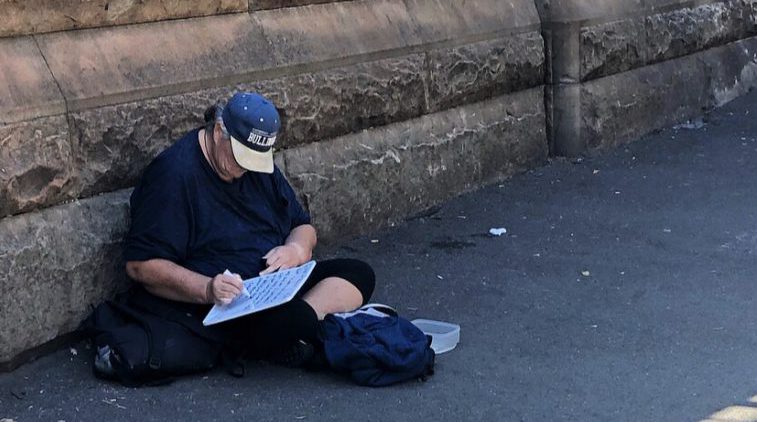Sarah’s hands are as cold as ice as they cradle the steaming cup of coffee with “a little bit of milk and one sugar”, just as she requested.
She has been homeless for nine years and says the anxiety she experiences at night and the risk of being hurt mean she rarely sleeps.
However, she would “rather sleep on the streets than be beaten up every day”.
Sarah, 40, from Punchbowl, in western Sydney, got married at 22 to a man she thought was “the love of her life”. It wasn’t until a year later that his violent character emerged and she was beaten daily, sometimes ending up with broken bones. The attacks were always complemented by verbal abuse. She recalls:
“Sometimes I thought I would throw up with the fear of what he would do next. He was very unpredictable.”
She is not the only woman to find herself alone and vulnerable on the streets.
Homelessness is on the rise across Australia, and NSW has the highest number of people living rough – more than 28,000. A recent study by RMIT University found that about 11 percent of women have slept rough at some point, equating to half a million women.
Family violence lies behind 31 per cent of those stories, closely followed by the shortage of affordable housing (28 per cent), with low-income earners forced out of their homes.
The smallest portion of the homeless population, at seven per cent, consists of people with mental health and substance abuse issues.
Women on the streets are vulnerable at the best of times, but certain locations in Sydney have been identified as being more perilous than others.

A report by Plan International, entitled Unsafe in the City, found that the most dangerous spots in Sydney, in terms of the threat of sexual harassment and rape, are Town Hall in the CBD, neighbouring Hyde Park, Newtown’s King Street, Central Station and nearby Belmore Park.
For women like Sarah, that threat is real. She currently sleeps under a bridge on Eddy Avenue, directly opposite Central Station.
Her worn-out sleeping bag nestles atop some battered cardboard boxes which she has carefully arranged to establish her own square of ownership within a tunnel of pavement.
The bridge offers some shelter from rain and wind, but all concrete and dirt, it remains a dank habitat.
“I don’t ever walk on that side of the road at night time,” says Acalya Cingoz. She works around the corner on Elizabeth Street and has to walk along Eddy Avenue after work to catch her bus.
“There are a lot of scary people around this area late at night and as a woman I definitely don’t feel safe.
“I can only imagine how a woman who is homeless must feel, without anywhere to hide, you know? Maybe they do find places to be?
“The women that I have seen around this area always look very skinny and unwell. It is so sad.”
Australian charity The Rough Period is one of the agencies making a difference for women like Sarah. They supply women with toiletries and sanitary items. Anthony, a regular volunteer, believes charities like his are “vital in this current climate”.
For many homeless women, Sydney rentals are unaffordable, and one of the most crucifying things is that many choose to live on the streets, believing it safer than government boarding houses.
Kate, 26, from Bankstown, in south-western Sydney, grew up surrounded by alcohol and drugs. She was sexually abused at 10 by her father’s best friend and, as a result, turned to alcohol and marijuana to “numb the pain”.
“I was too afraid to tell anyone what was happening,” she says. “He was a scary man. He would come into my bedroom when everyone was out because he had a spare key.”
By 16, Kate was on heroin. When she finally told her parents about the abuse, they didn’t believe her and threw her out.
“My first night on the street was awful. I was shaking, I was so scared.
“I didn’t have no one. I didn’t know if I would wake up dead. I just didn’t know what was going to happen to me.”
According to Homelessness Australia, on any given night in Australia one in 200 people is homeless.
Anglicare’s Rental Affordability Snapshot reveals that women over 55 are the fastest-growing category of people experiencing homelessness.
“At first I would cry all the time,” Sarah says. “Nowadays I can’t remember the last time I cried. I have more to worry about than feeling sorry for myself.
“For some reason, this is my life now.” She smiles. “You get to a point where you just have to accept that.” – @WolfJodie
For help, call 1800RESPECT, or Lifeline 13 11 14.


